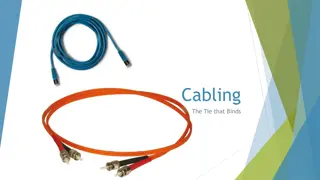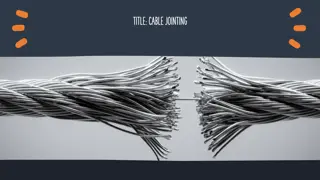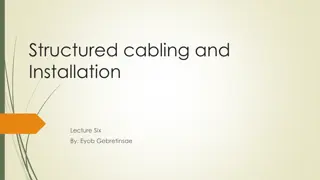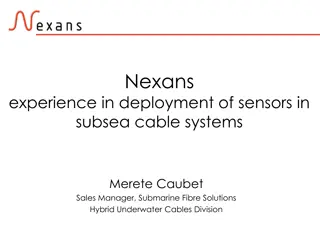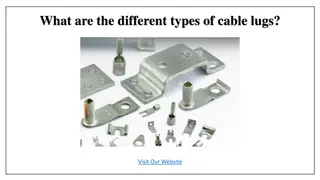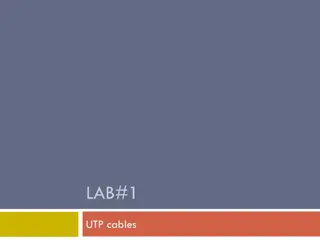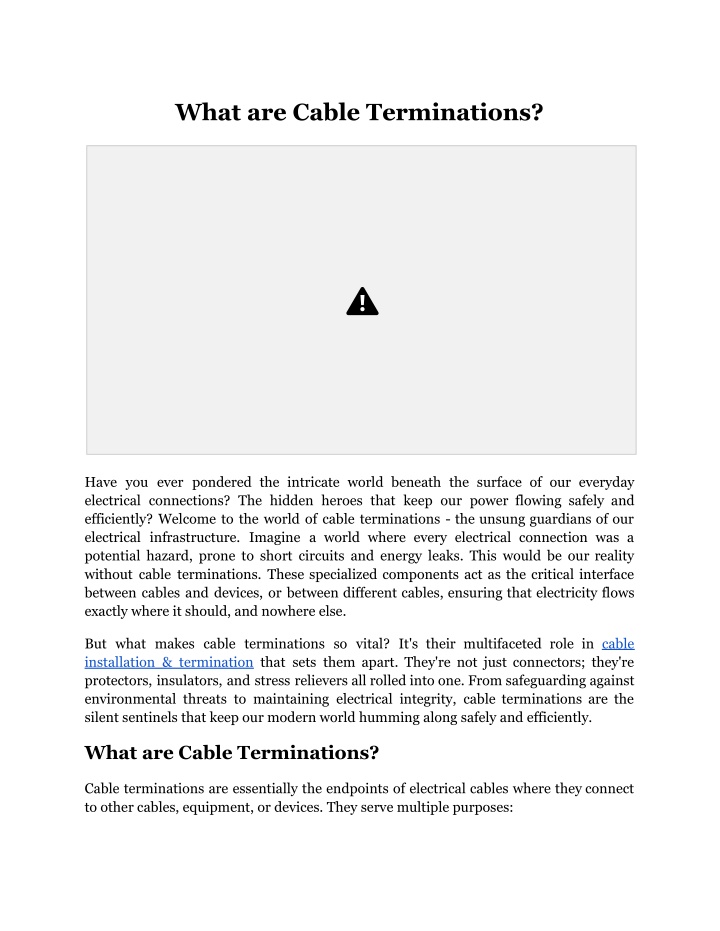
What are Cable Terminations?
Discover the essentials of structured cabling and learn why it's crucial for your network's efficiency and future growth.
Download Presentation

Please find below an Image/Link to download the presentation.
The content on the website is provided AS IS for your information and personal use only. It may not be sold, licensed, or shared on other websites without obtaining consent from the author. If you encounter any issues during the download, it is possible that the publisher has removed the file from their server.
You are allowed to download the files provided on this website for personal or commercial use, subject to the condition that they are used lawfully. All files are the property of their respective owners.
The content on the website is provided AS IS for your information and personal use only. It may not be sold, licensed, or shared on other websites without obtaining consent from the author.
E N D
Presentation Transcript
What are Cable Terminations? Have you ever pondered the intricate world beneath the surface of our everyday electrical connections? The hidden heroes that keep our power flowing safely and efficiently? Welcome to the world of cable terminations - the unsung guardians of our electrical infrastructure. Imagine a world where every electrical connection was a potential hazard, prone to short circuits and energy leaks. This would be our reality without cable terminations. These specialized components act as the critical interface between cables and devices, or between different cables, ensuring that electricity flows exactly where it should, and nowhere else. But what makes cable terminations so vital? It's their multifaceted role in cable installation & termination that sets them apart. They're not just connectors; they're protectors, insulators, and stress relievers all rolled into one. From safeguarding against environmental threats to maintaining electrical integrity, cable terminations are the silent sentinels that keep our modern world humming along safely and efficiently. What are Cable Terminations? Cable terminations are essentially the endpoints of electrical cables where they connect to other cables, equipment, or devices. They serve multiple purposes:
Protection: They shield the cable ends from environmental factors like moisture, dust, and physical damage. Electrical Insulation: They prevent electrical leakage and maintain the integrity of the electrical connection. Stress Relief: They reduce mechanical stress on the cable, preventing damage to the conductors. Connection Facilitation: They provide a safe and secure means of connecting cables to other components. Read More Article: What is Structured Cabling? And Why You Should Care? Types of Cable Terminations There are various types of cable terminations, each designed for specific applications and cable types. Here are some common ones: Crimp Terminations: Used with crimping tools to create a secure connection Ideal for low and medium-voltage applications Examples: Ring terminals, spade terminals, butt splices Mechanical Terminations: Use screws or bolts to secure the cable Easy to install and remove Suitable for temporary or adjustable connections Heat Shrink Terminations: Use heat-shrinkable materials to create a tight seal Provide excellent insulation and protection against moisture Commonly used in outdoor and marine applications Cold Shrink Terminations: Similar to heat shrink but doesn't require heat for installation Pre-expanded sleeves that shrink when the core is removed Ideal for situations where heat application is not possible or safe Plug and Socket Terminations: Allow for quick connect and disconnect
Common in consumer electronics and industrial equipment Examples: USB connectors, power plugs, industrial connectors Comparison of Cable Termination Types Type Installation Method Advantages Disadvantages Crimp Crimping tool Strong, connection reliable Requires tools special Mechanical Screws/bolts Easy to install and adjust May time loosen over Heat Shrink Heat application Excellent insulation Requires source heat Cold Shrink Manual expansion No heat required Limited options size Plug and Socket Simple connection Quick connect/disconnect Limited capacity current The Importance of Proper Cable Termination Proper cable installation & termination is crucial for several reasons: Safety: Correctly terminated cables reduce the risk of electrical accidents, short circuits, and fires. Performance: Well-terminated cables ensure optimal electrical performance and signal integrity. Longevity: Proper terminations protect cables from wear and tear, extending their lifespan. Compliance: Many industries have terminations to ensure safety and reliability. strict regulations regarding cable
Steps in Cable Termination The process of cable termination is a precise sequence of steps that ensure the safety and efficiency of electrical connections. Each step is crucial and requires attention to detail. Here's a breakdown of the process: Cable Preparation: Measure and mark the cable Remove the outer jacket Strip individual conductors Conductor Preparation: Clean the conductors Apply conductive paste if required Insulation: Apply insulating materials Ensure proper coverage and thickness Stress Control: Apply stress control materials for medium and high voltage cables Outer Protection: Install outer protective layers Seal against environmental factors Testing: Conduct electrical tests to ensure proper termination Each of these steps plays a vital role in creating a secure and reliable cable termination. Skipping or improperly executing any step can lead to performance issues or safety hazards. It's important to follow manufacturer guidelines and industry standards throughout the process. Proper tools and materials are essential for each step, from precision cutting tools for cable preparation to specialized testing equipment for the final verification. Read More Article: Why Are Carnegie House Apartments So Cheap?
Choosing the Right Cable Termination Selecting the appropriate cable termination depends on several factors: Cable Type: Different cables (e.g., power cables, data cables) require specific termination methods. Voltage Rating: Higher voltage cables need more robust termination techniques. Environmental Conditions: Outdoor installations may require weatherproof terminations. Application: The specific use case (e.g., permanent installation vs. frequent disconnection) influences the choice. Industry Standards: Certain industries have specific requirements for cable terminations. Common Mistakes in Cable Termination Even experienced professionals can make mistakes in cable termination. Some common errors include: Incorrect stripping length Over-tightening mechanical connections Using the wrong size or type of termination Failing to account for environmental factors Neglecting proper insulation and stress control Maintenance and Inspection of Cable Terminations Regular maintenance and inspection of cable terminations are essential to ensure continued safe operation. This includes: Visual inspections for signs of damage or wear Thermal imaging to detect hot spots Electrical testing to verify insulation integrity Retightening of mechanical connections Cleaning and reapplication of protective coatings as needed Powering the Future, One Termination at a Time Cable terminations may seem like small components, but they play a vital role in our electrical infrastructure. From ensuring safety and reliability to optimizing performance, proper cable termination is crucial in powering our modern world. As technology
advances, so too will cable termination techniques, continuing to provide the secure connections we rely on every day. With ongoing innovations in materials and design, cable terminations will continue to evolve, contributing to a more efficient and sustainable energy future. Meet Georgia Technical Services - Your trusted partner for expert cable termination and electrical solutions! With years of experience and a commitment to quality, we ensure safe, efficient, and compliant installations for all your electrical needs. From residential to industrial applications, count on us for top-notch service and peace of mind. Site Article: What are Cable Terminations?











